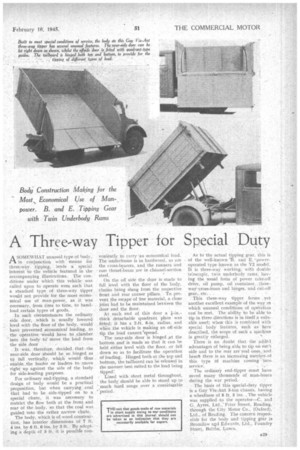A Three-way Tipper for Special
Page 39

If you've noticed an error in this article please click here to report it so we can fix it.
Duty
ASOMEWHAT unusual type of body, in conjunction with • means for three-way tipping, lends a special interest to the vehicle featured in the accompanying illustrations. The conditions under which this vehicle was called upon to operate were such Lhat a standard type of three-way tipper would not provide for the most economical use of .man-power, as it was necessary, from time to time, to handload certain types of goods.
In such circumstances the ordinary side door, which is usually lowered le.vel with the floor of the body, would have prevented economical loading, as the operative ' would, have to clamber into the body to move the load from the side door
, It was, therefor,e, decidedthat the near-side door .should be so.hin For ordinary end-tipping, a standard design of body would be a practical proposition, but when carrying coal that had to be side-tipped on to a special chute, it was necessary to restrict the flow both at the front and rear of the .body, so that the coal AA as guided, into the rather narrow chute. The body, which is of wood construction, has interior dimensions of 7 ft. 4 ins. by 6 ft. 6 ins. by 3 ft. By adopting a depth of 3 ft. it is possible con vertiently to carry an economical load. The underframe is in hardwood, as are the cross-bearers, and the runners and ram thrust-beam are in channel-section steel. On the off side the door is made to fall level with the floor of the body, chains being slung froni the respective front and rear corner pillars. To. prevent the escape" of fine material, a close joint had to be maintained between the door and the floor. At each end of this door a 1,-in.thick. detachable quadrant plate. was fitted; it has a 2-ft. 6-in, radius, and Wlien the vehicle is making an off-side tip the load cannot 'spread. The near-side door is hinged „at the bottom and' is made so that it can be held either level with the floor, or fall down so as to facilitate the operation of loading. Hinged both at the top and bottom, the tailboard can be released.in the manner best suited to the load being tipped: " Lined with sheet metal throughout, the body should be able to stand up to ' much hard usage over a considerable ' 'period. As to the actual tipping gear, this is of the well-known T. and E. operated type type -known as the Y,2 model. It is three-way working; with double telescopic, twin underbody rams, having the usual form of power take-oil drive, oil pump, oil container, . threewaY-crossirons and hinges, and eu:_ort gear,. etc... Thisthree-way tipper forms . yet another excellent example of the way in which unusual conditions of opeMlion can be met. The ability to be able to tip in three directions is in itself a valuable asset; when this is combined with special body features, such as here desCribed, the scope of. such a machine is greatly enlarged. There is no doubt that the -added advantages of being able to tip On eat.'-t side and to the rear are real ones.. and. hench there is an increasing number-of this type Of machine coming "into service. .. • The ordinary end-tipper -must have saved many thousands of man-bouts during the war period. The basis of this special-duty tipper is a Guy Viz-Ant 3-ton chassis, having a wheelbase of 8 ft. 5 ins. .The vehicle was supplied to the operator—C., and G. Ayres, Ltd.,`Friat Street, Reading, through the City Motor Co., (Oxford), Ltd., of Reading. The concern responsible for the body and tipping gear is Bromilow ad Edwards, Ltd., Foundry Street, Bolt-bn, Lancs.




























































